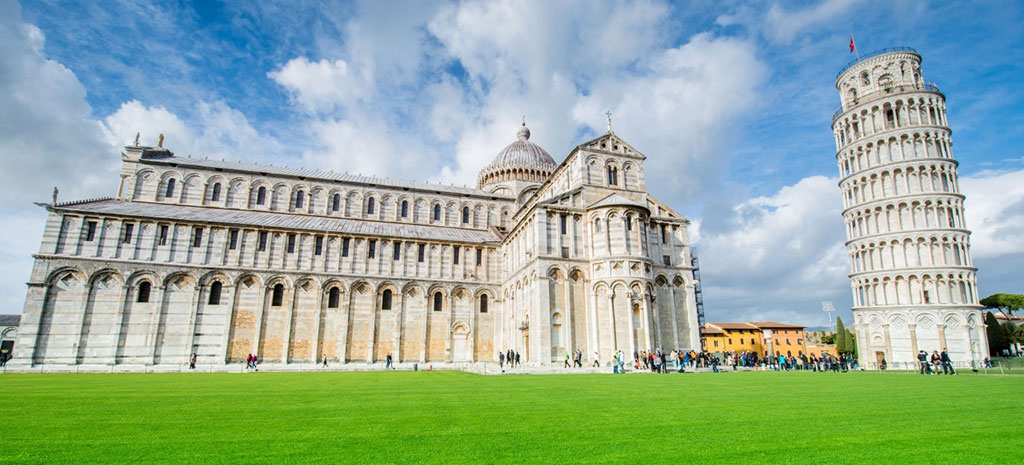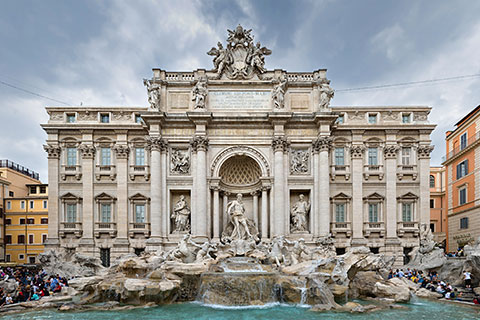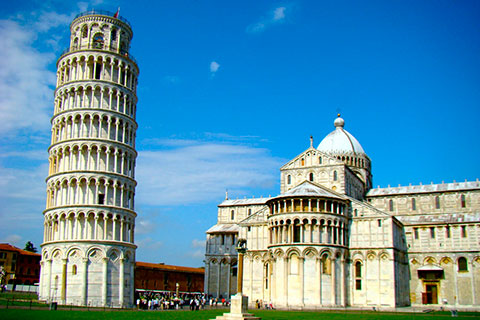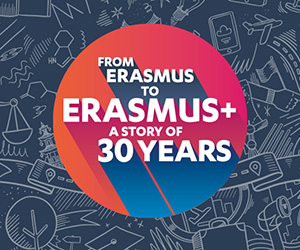
Study in Italy
Last edited on 27 Dec 2025
Ciao! Benvenuto in Italia!
Hi! Welcome to Italy!
Italy is a parliamentary republic located on the Mediterranean Sea, in the South of Europe. Come to Italy and study here! You will be impressed by our historical heritage. Rome, the capital of Italy, was the political center of the Western Civilization. Italy has played an important influence in Europe’s culture and society for centuries. In the 14th century a cultural, artistic and intellectual movement began in Florence, Tuscany, and spread to the rest of Europe: Italy is the birthplace of the Renaissance.
The country itself has plenty of charms which tempt tourist and international student; a diverse landscape; an immense cultural and historical legacy; iconic and historic sites including Rome’s Colosseum and Pisa’s Leaning Tower; incomparable cuisine; an impressive history of inventions and discoveries. Nest to that, Universities in Italy include some of the world’s oldest and most prestigious.
Italy boasts the greatest number of UNESCO world heritage sites in the world and it is also the home of the oldest European University - the University of Bologna, which was established in 1088. Many of Italy’s scientists have made an outstanding contribution to modern science, in particular in physics, chemistry, material science, medicine and literature. Art and culture play a very important role in a country where beauty, design, good taste and fashion are an everyday imperative. This, coupled with a high quality of University education, makes Italy an ideal place for living and studying.
Higher Education System
Under the Bologna Process, Italy has implemented the “nuovo ordinamento” (literally, “new rules”) system, replacing the former “vecchio ordinamento” (literally, “old rules”). Higher education in Italy now consists of a three-year bachelor’s degree called the laurea triennale, which can be followed by the two-year master’s degree (laurea magistrale, previously called laurea specialistica).
There is a credit system in place to quantify the amount of work needed to pass each course (eg. 25 work hours = 1 credit), as well as an opportunity to change your course or continue your studies abroad after three years. Students who are intending to study law have to take the five-year “Laurea Magistrale a Ciclo Unico”, while medicine students have to take a six-year degree.
Language requirements for studies at universities in Italy
Italian
According to Italian regulations regarding access to university studies, students are required to have an adequate knowledge of the Italian language as it is the usual language of instruction. In general, you need to have a minimum level of Italian corresponding to B2 in the Europass Language Passport classification. If your level of knowledge of Italian corresponds to C1 or C2 in the Europass Language Passport classification, you will be exempted from taking the Italian language test.
Unless your level of knowledge of Italian corresponds to C1 or C2 as previously explained, you will be required to pass a test of Italian language. The test will be organized by the institution where you will be studying, usually in September.
English
If your study program or course is taught in English, you will be required to prove your level of command of English by presenting the results you received at English courses. Please, always check with your university whether your English studies are sufficient for you to meet this requirement.
Student Cities in Italy
Rome

Where to start if not with the Italian capital? Well, most people probably start with the main sights – the Colosseum, the Trevi Fountain, the Pantheon, the Roman Forum, the Spanish Steps or the catacombs. But as a student in Rome, the fun lies in discovering new sides to the “Eternal City”.
You might take in a show in one of Rome’s many theaters, or enjoy a large outdoor performance at the Stadio Flaminio or Olympic Stadium. If you’re keen on literature, why not enjoy a night out at a ‘book bar’ – a fusion of bar, library and book club? For bargain hunters, Rome’s antique fairs and flea markets offer reams of vintage and second-hand goodies. If you’re brave enough, you might even rent a scooter and try to navigate the notoriously chaotic Roman traffic.
There are a range of excellent universities in Rome, particularly the Sapienza - Università di Roma which is ranked joint 223rd in the QS World University Rankings 2016-2017 , making it Italy’s third highest-ranked university. Other notable universities in Rome include the Universitá degli Studi di Roma - Tor Vergata (ranked 481-490 in the world) and the Università degli Studi Roma Tre (701+).
Milan
Celebrated as one of world’s best cities for students, Milan offers the full package: world-class universities, a high standard of living, and a large and diverse student population. A thriving economic hub in the north of Italy, Milan retains a strong sense of its past, while simultaneously representing modern urban Italian life.
The city’s cosmopolitan population coexists alongside a wealth of historical sites, including the church Santa Maria alle Grazie a UNESCO World Heritage Site which contains the famous painting The Last Supper. As well as being Italy’s leading financial center, Milan is recognized as a world leader in the fashion and design industries, designated a ‘Fashion Capital of the World’ alongside London, Paris and New York. If sports are more your thing, you’ll probably know Milan as the home of celebrated football teams AC Milan and Internazionale, known also as Inter Milan.
With eight universities in Milan, the city has the largest student community in Italy. Its higher education options include Italy’s highest entry in the 2016-17 rankings, Politecnico di Milano. Other internationally ranked universities in Milan include Università degli Studi di Milano (joint 370th), the Università Cattolica del Sacro Cuore (491-500) and the University of Milano-Bicocca (651-700), while the Università Commerciale Luigi Bocconi is known as one of Europe’s top business-focused universities. The Università degli Studi di Pavia (UNIPV), at 551-600 in the world rankings, is also located just south of the city of Milan and offers a range of international programs taught in English.
Pisa

Once you’ve climbed the famous Leaning Tower and taken one of those photos where you pretend to be holding it up, you’ll find there’s a lot more to Pisa than this iconic landmark! Pisa has more than 20 historic churches, several palaces and a series of stunning bridges across the river Arno. During the summer, you’ll find students relaxing along the banks of the river, sipping drinks from one of the area’s good wine bars.
While you might not find so many clubs or live music venues in Pisa, the city does offer some alternative music venues, disco bars and karaoke bars. Meanwhile, you can enjoy a leisurely dinner or drink at one of the city’s restaurants and bars, have a walk in Piazza Garibaldi and the riverside Lungarno, or treat yourself at one of Pisa’s spas.
The city gets much of its life from its student population, who organize all kinds of parties, shows and cultural events. Among universities in Pisa, the main one is the Università di Pisa, ranked 431-440 in the QS World University Rankings 2016-2017. The university’s most famous past student is Galileo Galilei, who studied there in the 16th century and went on to become one of the world’s most famous astronomers, physicists and inventors. Along with the University of Pisa, the Scuola Normale Superiore and the Sant’Anna School of Advanced Studies of Pisa make up the Pisa University System, which is recognized as one of Europe’s leading education hubs.
Bologna

Although less familiar to foreigners, Bologna is well-known among Italians, and not just because it is the largest city and capital of the Emilia-Romagna region. Bologna is known as the culinary capital of Italy, famous for its cuisine (la cucina Bolognese). It’s also been named a Creative City for Music by UNESCO, and is known for well-preserved historic center. The city’s pervasive shades of red, from terracotta to burnt oranges and warm yellows, have given it the nickname Bologna la rossa (Bologna the red).
Having developed around one of the world’s oldest universities, Bologna remains very much a university town, with a large and diverse student population. There is a thriving nightlife, active gay scene, good live music scene, and almost a hundred concerts every year featuring international rock, electronic and alternative bands. Other study-break activity options include a restored silent and sound films festival in July, three major car museums (Ducati, Lamborghini and Ferrari), and a Formula One collection.
Among universities in Bologna, the highest-ranked is the Università di Bologna (UNIBO) – which is Italy’s second-highest entry in the QS World University Rankings, at 208th. Other higher education institutions in Bologna include the Collegio di Spagna (within the University of Bologna, for Spanish students); the Academy of Fine Arts of Bologna, and the Collegio Superiore di Bologna. You might also consider taking some classes at the Carpigiani Gelato University, where you can learn to make authentic Italian ice cream.
Application, Fees and Visas in Italy
Applying to universities in Italy
University application procedures in Italy vary depending on whether you are an EU or a non-EU student, and whether you’re applying at undergraduate (referred to as ‘first cycle’) or graduate level (second and third cycle). The Universitaly website run by the Italian Ministry of Education has all the information you’ll need about applying to universities in Italy – but keep reading for an overview of key steps.
In general, the first step is to contact your chosen university to check the entry requirements for your degree program. Once your eligibility is confirmed, you must submit a pre-enrolment request form to the Italian Embassy or consulate in your country of origin along with the relevant documentation (see below). You will need to get your documents translated into Italian by an approved translator, in Indonesia the translation must be done by the Italian Cultural Institute. The form you need to fill out will vary depending on whether you are an EU or non-EU student and your degree subject. For example, non-EU students applying to study at institutions for arts, design, music and dance will need to fill in the form Model A-bis, while other students will need to fill the form Model A.
In Indonesia, documents you need to provide include:
- Completed relevant pre-enrolment form (Model A / Model A-bis);
- Copy of your school leaving qualification if you are an undergraduate applicant, or copy of your undergraduate qualification certificate if you are a postgraduate applicant, legalized by 1) your university; 2) Indonesian Ministry of Justice and Human Rights; 3) Indonesian Ministry of Foreign Affairs;
- Transcript of exams, including name of each passed exam, legalized by 1) your university; 2) Indonesian Ministry of Justice and Human Rights; 3) Indonesian Ministry of Foreign Affairs;
- A letter from your University/School stating when you enrolled in that School/University
- Two passport-sized photographs (3,5 x 4,5 cm) with white background.
If you choose an entirely Italian course taught, you need to provide proof of proficiency in Italian by presenting the results of an Italian language exam or, alternatively, you will take Italian exam in Italy (usually held in September)
At the Italian Embassy in Jakarta, an Uni-Italia Office is active since October 2012. Uni-Italia, founded on 30th July 2010 jointly by the Ministry of Foreign Affairs, the Ministry of Education, University and Research, the Ministry of Interior and the Italy China Foundation, has the aim of promoting Italian Higher Education and the mobility of foreign students and researchers towards Italian universities as well as encouraging academic cooperation between Italy and other foreign countries. The Association is present in several countries including China, Indonesia, Brazil, Vietnam and Iran. Uni-Italia works closely with Italian diplomatic offices abroad where Centres of promotion and orientation to study in Italy are located in. All these Centres cooperate with the Italian Cultural Institutes and the Italian Consulates abroad especially in promoting Italian higher education programs, selecting and assisting students with their first enquiries made in their own countries. The Association also assists students when they arrive in Italy and for the length of their stay with the aim of facilitating their integration into the new social, academic and cultural environment.
Applying for a visa to study in Italy
You will only be issued a visa to study in Italy if you can demonstrate that you:
- Have suitable accommodation in Italy;
- Have sufficient funds to cover all costs you might incur while studying in Italy (including tuition, accommodation, transport, textbooks and living costs);
- Have sufficient funds to be able to travel back to your country of origin at the end of your studies, or proof that you have already purchased a return ticket;
- Are entitled to medical care in Italy, either through private health insurance or an agreement between Italy and your native country;
- You might also need to show proof of certificate of payment in full for your degree program.
You can find out if you will need a visa to study in Italy using this handy tool offered by the Italian Ministry of Foreign Affairs (Ministero degli Affari Esteri).. You will also need to present all necessary documents giving evidence of the requirements outlined above, as well as:
- Entry visa application form
- recent passport-size photograph
- valid travel document whose expiry date is three months longer than that of the visa requested
- proof that the applicant has adequate accommodation in Italy
- proof that the applicant has sufficient means of subsistence of no less than € 448.52 for each month of the academic year. This can be proven in one of the following ways: evidence of personal or financial resources; economic guarantees provided by Italian institutions and bodies of an established credit, by local Governments, or by foreign institutions and bodies considered to be reliable by the Italian diplomatic mission
- enrolment or pre-enrolment in the course to be followed in Italy
- the requirements and procedures for the issue of visas are indicated in a special provision, published annually by the MIUR, in agreement with MAECI and Ministry of the Interior
Tuition fees, living costs and financial aid in Italy
Tuition fees at universities in Italy differ depending on the institution and course, as institutions set their own rates. According to government guidelines, average fees are between €850 and €1,000 (~US$900-1,060) per year at public universities in Italy, while private universities will be more expensive. Some specialized courses may also charge higher fees, while doctoral students could receive a grant from their university of choice will not need to pay fees.
In terms of living costs, you’ll need, approximately, €10,000 per year to cover accommodation, food, transport, entertainment and other expenses. When budgeting, you should keep in mind your lifestyle and spending habits, as well as where you’ll be based – major cities and tourist areas will be more expensive than smaller towns, especially in the north of Italy.
International students are eligible for the same scholarships and grants as local students, assessed by academic merit or financial need. This applies to scholarships, student loans, housing assistance, meal tickets and fee waivers. These services are managed by the university’s DSU Office (Diritto allo Studio Universitario – Right to Education), which also provides useful information and services for students including counseling, extra-curricular activities, sports, transport and other practical matters.
Furthermore, Indonesian students, interested to study in the field of Engineering, Advanced Technologies, Economy, Management, Architecture and Design, can apply to Invest Your Talent in Italy Scholarship, which call opens each year, usually, from November to end of April.
Other kind of scholarships available are from Italian Universities (requirements, deadline, etc depend on each University) and from the Italian Ministry of Foreign Affairs
Fast fact
- Official name: Italian Republic (Repubblica Italiana)
- Capital: Rome (Roma), nickname “The Eternal City”
- Unitary parliamentary constitutional republic
- Head of state is the elected President (currently Sergio Mattarella), and the government is led by the Prime Minister (currently Paolo Gentiloni).
- Borders with France, Switzerland, Austria and Slovenia
- Italy has numerous islands, and the mainland is famously shaped like a boot.
- There are two independent states within Italy, both enclaves: Republic of San Marino and Vatican City.
- Italy has the only active volcano in mainland Europe: Mount Vesuvius. Of Italy’s 14 volcanoes, three others are active: Mount Etna, Stromboli and Vulcano.
- Europe’s third-largest economy, eighth largest in the world
- 51 UNESCO World Heritage Sites, more than any other country
- Official language: Italian. Other recognized linguistic groups have co-official status including French, German.
- Main religion: Roman Catholic
- Currency: Euro (€)
- Main exports: engineering products, textiles and clothing, machinery, motor vehicles, transport equipment, chemicals, tobacco, minerals, nonferrous metals, food and beverages
- Italy’s national football (soccer) team has won the FIFA World Cup four times, in 1934, 1938, 1982 and 2006 – only Brazil has been more successful.
- Other popular team sports in Italy include volleyball, basketball, rugby, Formula 1 and Moto.
- There is a European law safeguarding the ‘traditional Italian pizza’.
- Daily, 3.000 € thrown into the Trevi Fountain in Rome. All donated in charity.
- Italy is the fifth most visited country in the world
- The language of music is in Italian (for example mezzo, lento, andante, allegro, vivace and presto).
- Famous Italian cheeses include Parmesan, from the Parma area in Northern Italy, mozzarella, traditionally made using Italian buffalo milk and pecorino, made by sheep milk.
- Time zone: Central European Time (UTC+1), UTC+2 in the summer
Let’s move to Southern Europe – Italy – country of charms with a diverse landscape; an immense cultural and historical legacy; iconic and historic sites including Rome’s Colosseum and Pisa; incomparable cuisine; an impressive history of inventions and discoveries. Boring? What about famous Italian fashion houses? You must very aware of it.
Not forget to mention, the international environment at Italy’s universities along with some of the world’s oldest and most prestigious ones! Ready to study in Italy? Here are some accesses to finance your study or you could find more advice on study in Italy by contacting Uni-Italia (country representative office for education).
Regional Authority Scholarships
Italian Local/Regional Government generously offers international students financial support in the form of free meals or discount coupons, tuition fee partial/full waiver, monthly allowance or free accommodation. For first-year students who enroll in the first year of any degree course, the competition only takes into account the requirements relative to their economic situation. To be able to apply for the scholarships, a list of documents (hard copy) needed to be sent to Uni-Italia’s office in Jakarta for Indonesian applicants
Invest your Talent in Italy
Focus Scholarship: Master and PhD
Competition: Designated country: Azerbaijan, Colombia, Egypt, Ethiopia, Ghana, India, Indonesia, Iran, Kazakhstan, Mexico, Turkey, Tunisia and Vietnam
Scholarship Coverage: Full Scholarship
""Invest Your Talent in Italy"" initiated by The Ministry of Foreign Affairs and International Cooperation - Directorate General for the Promotion of the Country System, in collaboration with Uni-Italy, ICE Agency, with the support of Unioncamere and Confindustria. The program aims to strengthen the internationalization of both enterprises and the Italian university system. What set this scholarship different from other programs is by offering integrated high academic education and training in the company. This scholarship is only available for Master and postgraduate programs.
Criteria
- Hold a three or four years Bachelor"s degree.
- Candidate have already applied for admission to one of the Invest Your Talent in Italy courses
- Specific entry requirements will depend on the chosen course.






